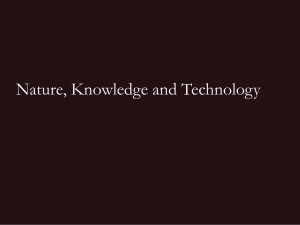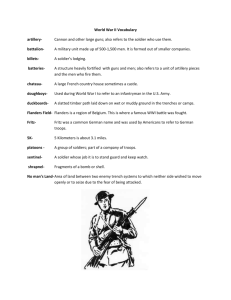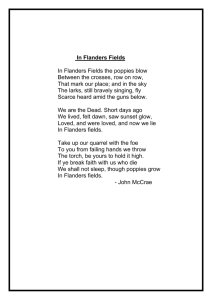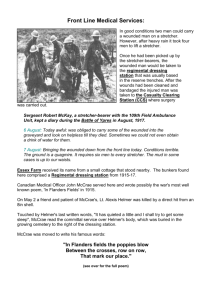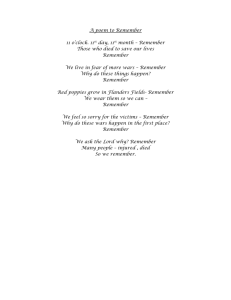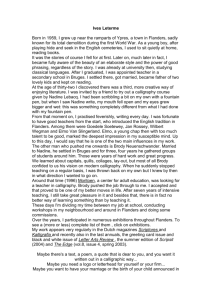Areas - Belgian Design Forum
advertisement
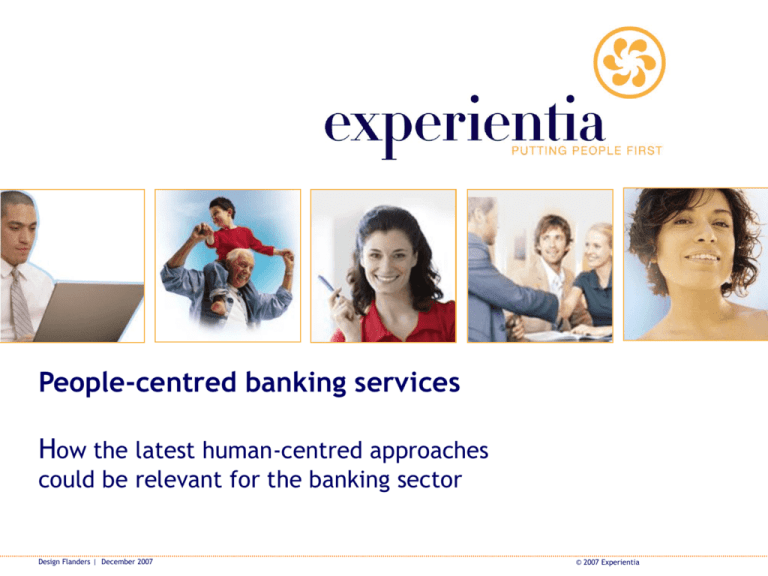
People-centred banking services How the latest human-centred approaches could be relevant for the banking sector Design Flanders | December 2007 © 2007 Experientia Areas Design Flanders | December 2007 © 2007 Experientia Areas Four major areas that could benefit most from human-centred design Professional application development Transactional websites Branch design Mobile banking services Design Flanders | December 2007 © 2007 Experientia 3 Areas Professional application development Financial software applications used by bank staff and running on server or on bank intranet Often developed with technical, security and business specifications only Development is rarely done in-house Banking staff is usually not strongly involved in development Limited contextual understanding of staff needs and requirements Design Flanders | December 2007 © 2007 Experientia 4 Areas Professional application development Applications are difficult and cumbersome to use They are not intuitive More time involved in interacting with applications, less time in interacting with customers More errors Less engagement Less awareness of full functionalities Design Flanders | December 2007 © 2007 Experientia 5 Areas Transactional websites Most banking transactions can currently be performed on the web, some transactions can only be done online End-users are not experts in this Customers will fall back on banking staff whenever there are problems, which is costly and time-consuming Design Flanders | December 2007 © 2007 Experientia 6 Areas Branch design The role of branches has changed with most operations being online No longer primary place for the handling of small procedures Instead environment for more strategic processes that require person-to-person interaction Branch design has often not evolved to accommodate this cultural/social change Design Flanders | December 2007 © 2007 Experientia 7 Areas Branch design Anonymous, cold environment Privacy concerns Opening hours not convenient QuickT ime™ and a decompressor are needed t o see this pict ure. Spaces are not thought from needs of current types of users (single people, parents, elderly), nor the current types of uses (longer, more strategic conversations) Design Flanders | December 2007 © 2007 Experientia 8 Areas Mobile banking Currently in experimental phase Some SMS based services (security alerts) But mainly WAP/Internet based (e.g. Movo in France for small transfers) Exploration of mobile based payments through near field technology and sema codes In general, still very desktop based Design Flanders | December 2007 © 2007 Experientia 9 Areas Mobile banking in Africa Weak institutional banking system More bottom-up innovation M-Pesa in Kenya (with Vodafone) and Wizzit in South Africa Extensive user research done by Nokia and Samsung Design Flanders | December 2007 © 2007 Experientia 10 Areas Mobile banking in Africa Companies most interested in this are NOT banks BUT handset manufacturers and telecom operators Risk: banks loosing out on mobile banking market, just like record industry has lost out on music downloads markets Design Flanders | December 2007 © 2007 Experientia 11 Human-centred design Design Flanders | December 2007 © 2007 Experientia 12 Human-centred design process People Understand In-depth understanding of user needs through observation and analysis User profiles Context Ideas Foresight Design Research and scenarios on future developments Scenarios User-centred design concepts and strategies Design specification Experience Touchpoints Test Prototypes Comprehensive usability analysis Implementation support Design Flanders | December 2007 Strong user experiences Iterative prototypes © 2007 Experientia 13 Foresight Identify future business opportunities Medium range scenarios about the way people will organise their lives in the future, what products and services they might need, and how they will use them, to help identify opportunities for design and innovation. Approach Context research Trend extrapolation Expert opinions (Delphi) Opportunity mapping Scenario development Deliverables Trend analyses Technology roadmaps Mood boards Scenarios of use Design Flanders | December 2007 © 2007 Experientia 14 Understanding Connect marketing research with in-depth user understanding To understand people’s experiences and behaviours and to grasp how they interact with products and services, we need to observe them in their own environments, analyse their conversations, flows and tasks, and use these qualitative insights to model product and services. Approach User experience modelling Contextual inquiry Design ethnography Interviews with extreme and lead users Conversation analysis Task and flow analysis Deliverables User profiles and personas Customer journey maps Experience models Scenarios Design Flanders | December 2007 © 2007 Experientia 15 Design Create user-centred strategies and design concepts Translate user and use needs and desired experience, into creative and human-centred strategies, concepts and designs, assuring compelling, desirable and useful solutions for the end-users, and added value for client companies. Approach Strategic design Innovation workshops Opportunity modelling Idea generation Concept development Communication design, interaction design, industrial design, information architecture Deliverables Concept visualisations Sketches Design drawings and models User and use requirements Design specifications Design Flanders | December 2007 © 2007 Experientia 16 Prototype Assure effective and strong experiences through prototyping By designing progressively more refined prototypes, we gain insights on what works with people and what doesn't, and why, and we can test user acceptance, usage benefits and drawbacks in various contexts, making sure that the end result is solid and valuable. Approach Just enough prototyping Iterative process Conceptual prototypes Appearance prototypes Functional prototypes Deliverables Lo-fi prototypes are developed with simple tools: paper, screen, video, wizard-of-oz, walkthrough… Hi-fi prototypes are more sophisticated: here we have applications, appearance models and functional models Design Flanders | December 2007 © 2007 Experientia 17 Test Deliver robust products and services through comprehensive user testing Experientia’s rich methodology to assess, measure and evaluate the user experience delivers qualitative results that help companies and organisations to tightly align their products and services with their users’ needs. Approach Participatory methods Heuristic evaluations Cognitive walkthroughs Focus groups Usability testing Deliverables Usability analysis Prototype iterations Implementation support Design Flanders | December 2007 © 2007 Experientia 18 Implementing the approach Design Flanders | December 2007 © 2007 Experientia 19 First of all Observation Design Flanders | December 2007 © 2007 Experientia 20 Implementing the approach Software applications and transactional websites Trust and credibility are the key ingredients of any online banking service Trust requires care and control: a system that shows care and a user in full control who can do what he/she needs to do. Credibility is delivered by a consistent, reliable and highquality user experience. Design Flanders | December 2007 © 2007 Experientia 21 Implementing the approach Software applications and transactional websites Search Personalisation Navigation/IA Contextual support Thesaurus and glossary Example: a corporate intranet Design Flanders | December 2007 © 2007 Experientia 22 Implementing the approach Branch design Participation and engagement Developed around people’s needs Example: the pharmacy of the future Design Flanders | December 2007 © 2007 Experientia 23 Implementing the approach Mobile service development The interface is everything (and it is small) Understanding context of use Anticipating future technologies Example: work for Swisscom and Deutsche Telekom Design Flanders | December 2007 © 2007 Experientia 24 Thank you Design Flanders | December 2007 © 2007 Experientia 25 Experientia s.r.l. Via Cesare Battisti 15 10123 Torino Italy T +39 011 812 9687 Partners Mark Vanderbeeken Michele Visciola Jan-Christoph Zoels Pierpaolo Perotto info@experientia.com www.experientia.com Design Flanders | December 2007 © 2007 Experientia 26

